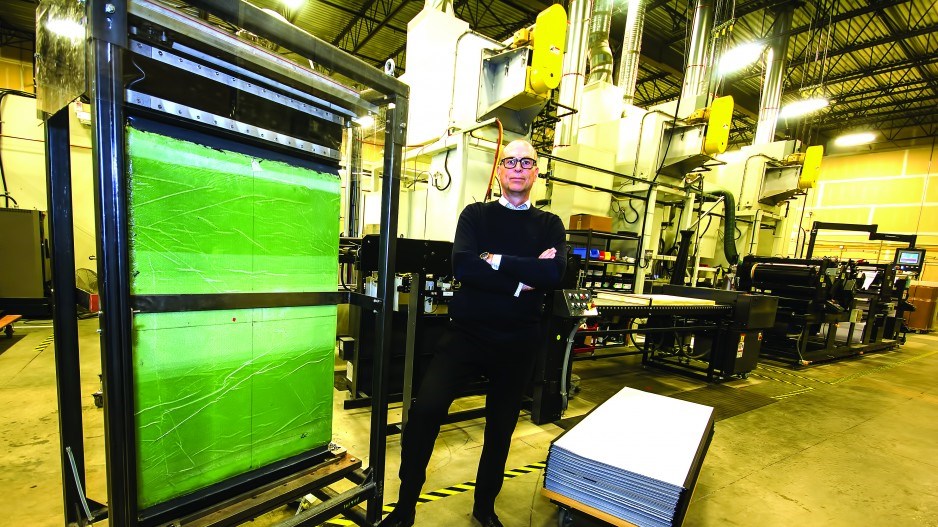In the Canadian carbon-capture space, Carbon Engineering has been grabbing most of the headlines lately.
The B.C. company recently closed a $90 million (US$68 million) equity financing round and is working to build its first commercial-scale direct-air capture plant. One of the products it can make with carbon captured from the air is a carbon-neutral jet fuel.
But another B.C. company, Inventys Inc., has also been landing some serious financing recently and inking multimillion-dollar partnerships with industry.
In February, Inventys raised $16 million in C-round financing, led by the Oil and Gas Climate Initiative (OGCI), a consortium of 13 of the world’s biggest oil and gas companies. The OGCI has a $1 billion fund for technology that addresses climate change issues in the oil and gas sector.
Inventys also raised $10 million in a separate financing round, led by Husky Energy Inc. (TSX:HSE) in 2017, and another $12.3 million in government grants as part of a $15 million demonstration plant being built in partnership with Husky.
That project will use technology developed by Inventys to capture CO2 at one of its steam-assisted gravity drainage operations near Lloydminster, Saskatchewan.
Inventys is also getting a US$3 million research grant from the U.S. Department of Energy.
“There’s a corporate will from the major oil and gas to really address this thing,” said Claude Letourneau, who was brought on as Inventys’ CEO two years ago to take the technology company to the commercialization stage.
The demonstration plant Inventys will build in Saskatchewan could scale up to capture 30 tonnes of CO2 per day.
“That’s a big plant,” Letourneau said.
Carbon-capture technology has been around for decades. Most carbon capture from industrial flue stacks uses a liquid amine process. Inventys developed a different, more cost-effective approach – using an “adsorption” material that, when placed in a flue stack, attracts the CO2 a bit like a magnet.
Inventys says its adsorption process is half the cost of conventional technology. At larger scales, Letourneau said, Inventys believes it can capture CO2 at $30 per tonne, compared with $60 to $80 per tonne for the conventional liquid amine process.
“We need to reduce by half the cost of CO2,” Letourneau said. “That’s basically the code we were able to crack from a technology point of view.”
Even at that price, it still doesn’t make economic sense to capture the carbon and sequester it underground. For that to work, carbon would need to be priced at at least $60 per tonne, Letourneau said.
“The only way storage will work is to basically have a price on carbon that is higher than the cost of capturing it and storing it,” Letourneau said.
So for now, the biggest market for CO2 is in enhanced oil recovery, in which liquefied CO2 is injected underground in depleted oil wells to bring up whatever residual oil if left.
“I have a very market-driven approach, as opposed to a technology-push approach,” Letourneau said. “We’re trying to work with customers who have a CO2 need and are willing to pay for it.”
While it may sound counterproductive from a greenhouse-gas mitigation standpoint to use CO2 to help oil companies get even more oil out of the ground, the CO2 that is injected underground in enhanced oil recovery stays there. And it allows oil companies to maximize existing plays, instead of drilling new oil wells.
“That oil that you’re getting out of that existing oilfield means that you’re not drilling for oil somewhere else,” said Sandra Odendahl, president of the CMC Research Institutes. “You’re using the footprint you already have.”
Letourneau said that for every two barrels of oil extracted using enhanced oil recovery, a tonne of CO2 is sequestered underground. He likens it to putting $100 in your credit card account before spending $100.
“We are storing, in advance, the amount of CO2 you would have emitted,” Letourneau said.
Currently, of the seven gigatonnes of CO2 produced each year, only 0.08% is captured, Letourneau said.
“The only way you can do this thing quickly, to get to one to two gigatonnes – EOR [enhanced oil recovery]. Because people are willing to pay for that CO2.”
Inventys started 10 years ago as a clean-tech startup with four people. It now has a head count of 80 and just recently split off its research and development division from its manufacturing division, moving its R&D into a new facility in north Burnaby. Its manufacturing is done in south Burnaby.
“By the end of next year, we will have spent about $80 million Canadian to bring the technology from where it was 10 years ago – an idea in the heads of a couple of guys – to a complete demo plant and with probably a first purchase order in our hands by the end of next year for a commercial plant,” Letourneau said.
See related stories: The pipeline we do not know and Canadian carbon-capture companies




